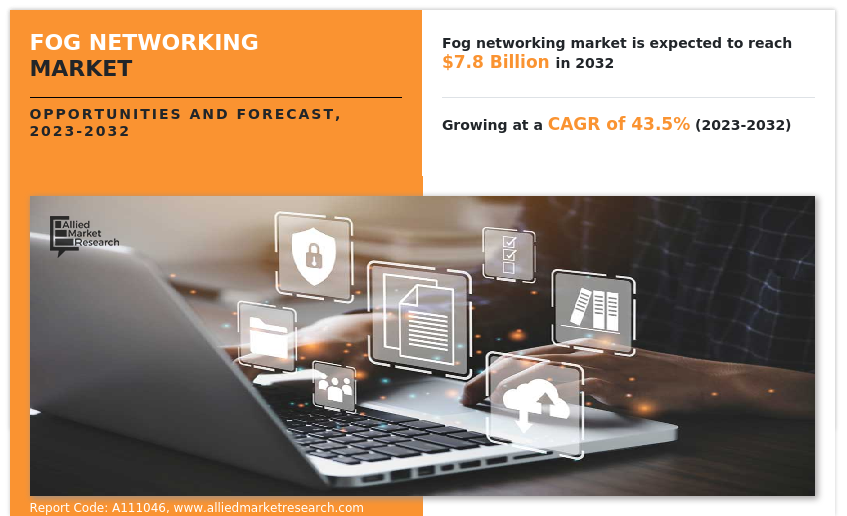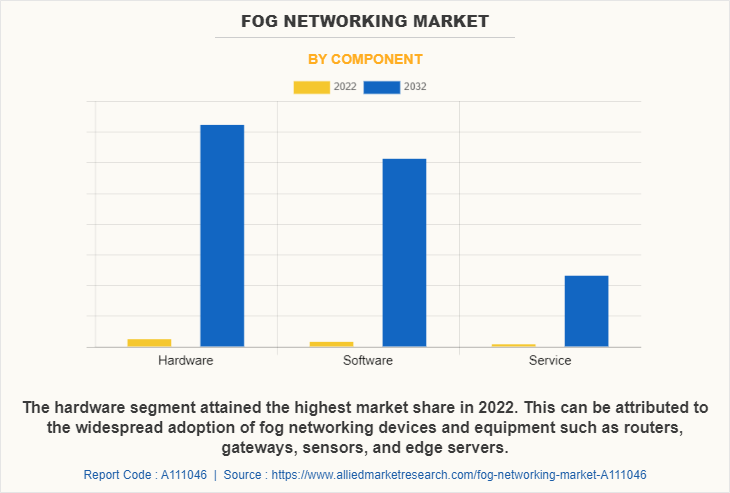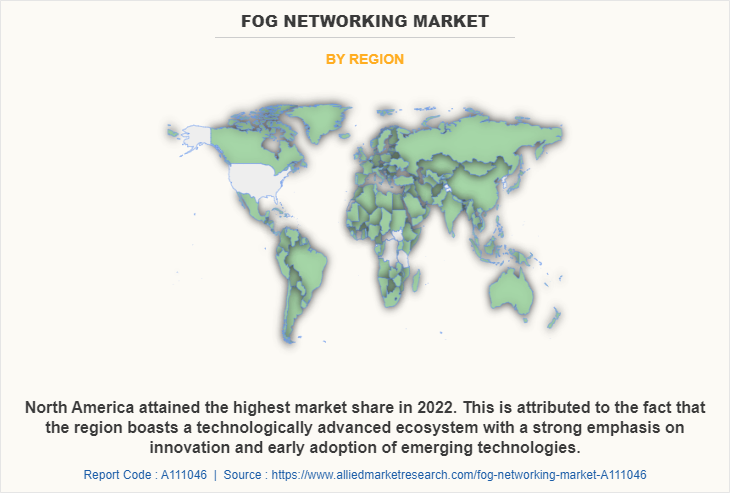Fog Networking Market Statistics, 2032
The global fog networking market was valued at $218.5 million in 2022, and is projected to reach $7.8 billion by 2032, growing at a CAGR of 43.5% from 2023 to 2032.
The report focuses on growth prospects, restraints, and trends of the market analysis. The study provides Porter’s five forces analysis to understand the impact of various factors, such as bargaining power of suppliers, competitive intensity of competitors, threat of new entrants, threat of substitutes, and bargaining power of buyers on the market.

Fog networking, also called fog computing or fogging, describes a decentralized computing structure located between the cloud and devices that produce data. This flexible structure enables users to place resources, including applications and the data they produce, in logical locations to enhance performance.
The proliferation of IoT devices is a major driver for fog computing. With billions of connected devices generating massive amounts of data, fog computing provides a decentralized architecture that enables data processing and analysis at the edge, closer to where the data is generated. This reduces latency, improves efficiency, and enhances real-time decision-making. Furthermore, advancements in edge computing infrastructure, such as the deployment of edge servers and miniaturized data centers, have paved the way for scalable and resilient fog networks. As a result, these advancements have fueled the growth of the market by enabling the development of innovative solutions across various industries, including healthcare, manufacturing, transportation, and smart cities, among others.
However, the infrastructure challenges such as limited connectivity, outdated equipment, bandwidth limitations, and cost considerations collectively impede the growth of the market. In addition, shortage of professionals with expertise in fog computing and the skill gap hampers the adoption and implementation of fog networking solutions, as organizations struggle to find qualified personnel to design, deploy, and manage fog computing infrastructure. On the contrary, fog computing offers scalable and cost-effective solutions by distributing computation and storage resources across edge devices. It also helps to eliminate the need for massive, centralized infrastructure, reducing infrastructure costs and enabling scalability based on demand.
Segment Review
The fog networking market share is segmented on the basis of component, application, and region. Based on component, it is segmented into hardware, software and service. By application, it is segmented into building & home automation, smart manufacturing, connected healthcare, smart energy, transportation & logistics, and others. Region wise, it is analyzed across North America, Europe, Asia-Pacific, and LAMEA.

On the basis of component, the hardware segment attained the highest market share in 2022. This can be attributed to the widespread adoption of fog networking devices and equipment such as routers, gateways, sensors, and edge servers. The hardware components play a crucial role in enabling the connectivity, data processing, and communication required for fog computing. However, the software segment is forecasted to be the fastest growing segment during the forecast period in the market. This growth can be attributed to the fact that software component forms the backbone of fog networking, enabling intelligent data processing, analytics, and decision-making at the edge of the network. With advancements in machine learning, artificial intelligence, and data management, fog networking software solutions are becoming more sophisticated and capable of handling complex tasks.

By region, North America emerged as the dominant region, capturing the highest market share in the fog networking industry. This is attributed to the fact that the region boasts a technologically advanced ecosystem with a strong emphasis on innovation and early adoption of emerging technologies. This has created a wide scope for the adoption of fog computing solutions, as organizations in North America recognize the potential of fog networks in enabling real-time data processing, reducing latency, and improving overall network efficiency. Furthermore, North America is home to several prominent fog computing solution providers, which has contributed to the availability of a wide range of offerings and increased market competition, further fueling the growth in the region.
However, Asia-Pacific is projected to become the largest segment during the forecast period. The forecasted growth in the Asia-Pacific region can be attributed to the fact that the region is experiencing rapid economic growth, resulting in increased investments in digital transformation initiatives across various industries. As a result, organizations in Asia-Pacific are increasingly adopting fog networking solutions to enhance their operational efficiency, leverage real-time data analytics, and support the growing demand for connected devices and IoT applications. In addition, the region's vast population and rising urbanization present significant opportunities for fog computing adoption, particularly in sectors such as smart cities, manufacturing, transportation, and healthcare.
The report analyzes the profiles of key players operating in fog networking market such as Arista Networks, Inc., Amazon Web Services, Inc., Cisco Systems, Inc., Dell Inc., Fujitsu, Google Cloud Platform, Huawei Technologies Co., Ltd., IBM Corporation, Intel Corporation., and Microsoft Corporation. These players have adopted various strategies to increase their market penetration and strengthen their position in the fog networking industry.
Market Landscape and Trends
The market has been witnessing significant growth and evolving trends in recent years. In addition, market landscape is characterized by a diverse range of players, including technology giants, networking equipment manufacturers, cloud service providers, and start-ups. One of the key trends in the market is the increasing adoption of Internet of Things (IoT) devices. As the number of connected devices continues to surge, the demand for localized data processing and analysis at the network edge has grown substantially. Thus, fog computing offers low-latency and real-time data processing, making it an ideal solution for IoT applications.
Furthermore, the fog networking market is witnessing the emergence of specialized fog computing hardware and software solutions. These solutions are designed to address the unique requirements of fog computing, such as resource-constrained edge devices, intermittent connectivity, and security concerns. Vendors are offering purpose-built fog nodes, edge gateways, and fog computing platforms that streamline deployment and management of fog computing infrastructure.
Hence, the market is experiencing rapid growth and dynamic trends driven by the proliferation of IoT devices, the integration of AI and ML, and the development of specialized fog computing solutions. Moreover, organizations across various industries are recognizing the benefits of fog computing in enabling real-time data processing, improving system responsiveness, and unlocking new opportunities for innovation. Therefore, these are some of the major market trends of fog networking market size.
Top Impacting Factors
Increase in Internet of Things (IoT) proliferation
With the ever-increasing number of connected devices and the massive amounts of data generated by these devices, traditional cloud computing architectures face several challenges in terms of latency, bandwidth constraints, and privacy concerns. This is where fog computing comes into play because fog computing extends the capabilities of cloud computing by bringing computing resources closer to the edge of the network, closer to the IoT devices themselves. Therefore, by distributing computing power and data storage across a network of fog nodes, fog computing enables faster processing and real-time analytics, reducing latency and enhancing the overall efficiency of IoT systems.
Furthermore, as the IoT ecosystem continues to expand, the demand for fog networking solutions grows in tandem, making it a crucial enabler for handling the massive influx of IoT data and ensuring seamless connectivity and efficient data processing. Thus, the proliferation of IoT acts as a significant driver for the fog networking market growth.
Edge computing infrastructure advancements
Edge computing infrastructure advancements have indeed played a significant role in driving the market, this is because fog computing, is a distributed computing paradigm that brings computation and data storage closer to the network's edge and has gained momentum due to the rapid growth of Internet of Things (IoT) devices and the need for real-time processing of data. Thus, with edge computing, the processing and analysis of data occur closer to the devices generating it, reducing latency and enabling faster response times. This infrastructure advancement has created opportunities for fog networking, which leverages the capabilities of edge devices, such as routers, gateways, and switches, to facilitate localized data processing and efficient resource utilization.
For instance, the integration of fog computing with autonomous vehicles allows them to process sensor data locally, enabling real-time decision-making and enhancing overall safety. Furthermore, advancements in edge computing infrastructure, such as the deployment of edge servers and miniaturized data centers, have paved the way for scalable and resilient fog networks. As a result, these advancements have fueled the growth of the market by enabling the development of innovative solutions across various industries, including healthcare, manufacturing, transportation, and smart cities, among others.
Infrastructure challenges
Infrastructure challenges significantly restrain the growth of the market, as fog networking relies heavily on robust and reliable infrastructure to enable efficient data processing and real-time analysis at the network edge. However, the existing infrastructure in many regions may not be adequately prepared to handle the demands of fog computing. Thus, limited connectivity options, outdated network equipment, and insufficient bandwidth can pose significant challenges for the deployment and scalability of fog networking solutions. Furthermore, inadequate connectivity options also hinder the seamless communication between fog nodes and cloud resources. Additionally, outdated network equipment may not support the advanced technologies and protocols required for fog computing, further limiting its adoption and growth.
Moreover, the cost associated with upgrading and enhancing the existing infrastructure to support fog networking can be a significant barrier. Many organizations may be reluctant to invest in infrastructure upgrades due to budget constraints or the perception of uncertain returns on investment. This financial restraint can slow down the expansion of fog networking deployments, particularly in areas where funding for infrastructure development is limited. Thus, these infrastructure challenges such as limited connectivity, outdated equipment, bandwidth limitations, and cost considerations can collectively impede the growth of the fog networking market. Hence, addressing these challenges will require substantial investments in upgrading infrastructure, expanding connectivity options, and optimizing bandwidth availability, enabling the realization of the full potential of fog computing.
Shortage of professional and skill gap
Fog computing, which extends cloud computing capabilities to the edge of the network, requires specialized skills and knowledge in areas such as networking, security, and data analytics. However, there is a shortage of professionals with expertise in fog computing, as it is a relatively new and evolving field. This skill gap hampers the adoption and implementation of fog networking solutions, as organizations struggle to find qualified personnel to design, deploy, and manage fog computing infrastructure. Hence, without the necessary skills, businesses may hesitate to invest in fog networking technologies, thereby impeding the market's growth potential. Therefore, addressing the skill gap through training programs and educational initiatives is crucial to unlocking the full potential of fog networking and driving its market expansion.
Integration with emerging technologies
As emerging technologies such as the Internet of Things (IoT), edge computing, and artificial intelligence (AI) continue to advance, the demand for efficient and decentralized data processing at the network edge becomes paramount. Furthermore, fog networking can be also combined with other emerging technologies such as 5G networks, machine learning, and blockchain, to unlock even more opportunities. For instance, the combination of fog computing and 5G enables ultra-low latency applications, while AI and machine learning at the edge enable real-time data analysis and decision-making.
Hence, by integrating fog networking with emerging technologies, organizations can unlock new possibilities in various domains, including smart cities, industrial automation, healthcare, and autonomous vehicles. This integration allows for seamless connectivity, optimized resource utilization, and enhanced data security. As a result, the market stands to benefit greatly from its integration with emerging technologies, driving innovation and fueling the growth of a more interconnected and intelligent digital ecosystem.
Key Benefits for Stakeholders
- This report provides a quantitative analysis of the market segments, current trends, estimations, and dynamics of the fog networking market forecast from 2023 to 2032 to identify the prevailing fog networking market opportunities.
- The market research is offered along with information related to key drivers, restraints, and opportunities.
- Porter's five forces analysis highlights the potency of buyers and suppliers to enable stakeholders make profit-oriented business decisions and strengthen their supplier-buyer network.
- In-depth analysis of the market segmentation assists to determine the prevailing market opportunities.
- Major countries in each region are mapped according to their revenue contribution to the global market.
- Market player positioning facilitates benchmarking and provides a clear understanding of the present position of the market players.
- The report includes the analysis of the regional as well as global fog networking market trends, key players, market segments, application areas, and market growth strategies.
Fog Networking Market Report Highlights
| Aspects | Details |
| Market Size By 2032 | USD 7.8 billion |
| Growth Rate | CAGR of 43.5% |
| Forecast period | 2022 - 2032 |
| Report Pages | 384 |
| By Component |
|
| By Application |
|
| By Region |
|
| Key Market Players | Intel Corporation., Cisco Systems, Inc., Huawei Technologies Co., Ltd., Fujitsu, Microsoft Corporation, IBM Corporation, Dell Inc., Arista Networks, Inc., Google Cloud Platform, Amazon Web Services, Inc. |
Analyst Review
The fog networking market has been witnessing significant growth and evolving trends in recent years. One of the prominent market trends is the growing adoption of fog computing across various industries, including manufacturing, healthcare, transportation, and smart cities. Furthermore, organizations are also leveraging fog networking to enable faster data analysis, reduce latency, and improve overall operational efficiency. Moreover, the proliferation of Internet of Things (IoT) devices and the rise of 5G networks have further propelled the demand for fog computing, as it enables efficient data processing and management at the edge, closer to the source. In addition, the integration of artificial intelligence (AI) and machine learning (ML) capabilities into fog networks is gaining momentum, enabling intelligent decision-making and predictive analytics. This trend is expected to drive the growth of fog networking market in the coming years. Furthermore, advancements in edge devices, fog platforms, and networking technologies are constantly enhancing the performance and capabilities of fog computing systems, fostering innovation and fueling market expansion. Hence, the fog networking market is positioned for continued growth as organizations recognize the immense potential of fog computing in enabling edge intelligence and unlocking new opportunities for business transformation.
Furthermore, market players are adopting strategies like product launch, business development, and collaboration for enhancing their services in the market and improving customer satisfaction. For instance, Citi Bank uses beacon technology to understand ATM users' purchasing behavior and provides incentives to customers to use Citi cards in local areas for transactions. Therefore, such strategies are expected to boost the growth of the fog networking market in the upcoming years.
Moreover, some of the key players profiled in the report are Arista Networks, Inc., Amazon Web Services, Inc., Cisco Systems, Inc., Dell Inc., Fujitsu, Google Cloud Platform, Huawei Technologies Co., Ltd., IBM Corporation, Intel Corporation., and Microsoft Corporation. These players have adopted various strategies to increase their market penetration and strengthen their position in the industry.
The fog networking market has been witnessing significant growth and evolving trends in recent years. In addition, market landscape is characterized by a diverse range of players, including technology giants, networking equipment manufacturers, cloud service providers, and start-ups. One of the key trends in the fog networking market is the increasing adoption of Internet of Things (IoT) devices. As the number of connected devices continues to surge, the demand for localized data processing and analysis at the network edge has grown substantially. Thus, fog computing offers low-latency and real-time data processing, making it an ideal solution for IoT applications.
North America is the largest regional market for Fog Networking Market
The estimated industry size of Fog Networking Market is $7,827.19 million by 2032
Arista Networks, Inc., Amazon Web Services, Inc., Cisco Systems, Inc., Dell Inc., Fujitsu, Google Cloud Platform, Huawei Technologies Co., Ltd., IBM Corporation, Intel Corporation., and Microsoft Corporation
Loading Table Of Content...
Loading Research Methodology...


